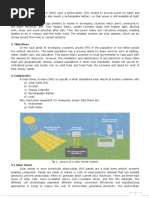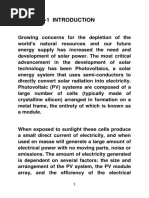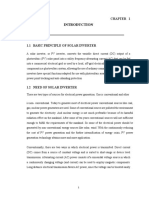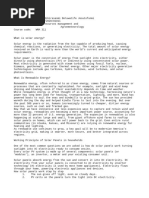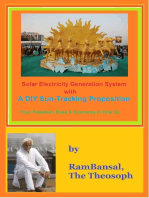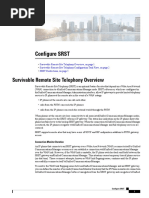Efficient Use of Solar Power Energy: Ruby Vij, Research Scholar D.A.V Institute of Tech. Jalandhar
Efficient Use of Solar Power Energy: Ruby Vij, Research Scholar D.A.V Institute of Tech. Jalandhar
Uploaded by
Pramod KumarCopyright:
Available Formats
Efficient Use of Solar Power Energy: Ruby Vij, Research Scholar D.A.V Institute of Tech. Jalandhar
Efficient Use of Solar Power Energy: Ruby Vij, Research Scholar D.A.V Institute of Tech. Jalandhar
Uploaded by
Pramod KumarOriginal Description:
Original Title
Copyright
Available Formats
Share this document
Did you find this document useful?
Is this content inappropriate?
Copyright:
Available Formats
Efficient Use of Solar Power Energy: Ruby Vij, Research Scholar D.A.V Institute of Tech. Jalandhar
Efficient Use of Solar Power Energy: Ruby Vij, Research Scholar D.A.V Institute of Tech. Jalandhar
Uploaded by
Pramod KumarCopyright:
Available Formats
International Journal of VLSI & Signal Processing Applications , Vol.
2, Issue 5, ISSN 2231-3133, (389-391)
EFFICIENT USE OF SOLAR POWER ENERGY
Ruby Vij, Research Scholar D.A.V Institute of Tech. Jalandhar
Abstract
Most people have little understanding of where their electricity comes from or where it goes. In power line connected homes, this can result in higher usage and higher bills. Likewise, with your own independent power system, lack of understanding of where the power goes can lead to higher costs, and even prevent it from working properly. This article will give an overview of how we design a typical solar electric power system for the individual home, and help you decide whether to seek your power from the SUN or from your local utility companya single solar cell to off-grid homes powered by photovoltaic array Solar energy, radiant light and heat from the sun, which can make considerable contributions to solving some of the most urgent problems the world now face.[1 Solar power is the conversion of sunlight into electricity, either directly using photovoltaics (PV), or indirectly using concentrated solar power . Photovoltaics were initially used to power small and medium sized applications, from the calculator powered by lower bills forever. Keywordssolar energy, photovoltaic, solar cell
using photovoltaics at all and your electric bill will drop dramatically. Reducing the Electric Bill First, switch from electric to wood, gas or thermal solar for all major heating, water heating, cooking and clothes drying appliances. The gas and wood substituted will cost less than the electricity you use to heat, and you will see overall savings after the cost of changing over is paid. Security If your interest is security from short term power outages then a battery backup system that is recharged by the power company will cost far less than complete solar power. As photovoltaics is not just a technology, or a way to be independent. Its not just a job and its not just the answer that powers my home. It also empowers an ethical, non-polluting, non-nuclear way of life, in harmony with the natural resources of the earth and of the individual home site. Its available right now, doing its job every day.
I. INTRODUCTION
The sun is the only significant source of energy to the earth. Received entirely as radiation, this energy is subsequently converted, so that at any given time and place; an original quantum may appear in any one of the several diverse forms. Within a geographic region subject to uniform atmospheric conditions, irradiation from the sky is fairly uniform, regardless of surface inclination. However, the total sun and sky irradiation varies widely with surface orientation and slope. The variation of direct beam radiation varies in time with atmospheric condition and path length, the combined effect of which can be estimated. Energy generated by the sun is radiated outwards in all directions, and only two thousandmillionths of it is intercepted by the earth as light and infrared (heat) radiation. On average, only about half of the energy reaches the earth's surface (due to scattering, absorption and reflection). Within a geographic region subject to uniform atmospheric conditions, irradiation from the sky is fairly uniform, regardless of surface inclination. However, the total sun and sky irradiation varies widely with surface orientation and slope. If your interest is to reduce the bill from the power company for your present house, where you have power lines installed already, I do not recommend photovoltaics at todays prices. Appliances we will discuss allows our home to function comfortably on less than 20% of the power a typical home uses. You can do the same without
II. HOW SOLAR POWER WORKS
Photovoltaic modules convert sunlight to DC electricity when sunlight shines on their surface. Modules are constructed of glass and silicon crystal or sometimes noncrystal cells. There are no moving parts and the cells do not wear out with use. Mounts for photovoltaic modules are usually aluminum rails that hold the modules facing the noon sun atop a roof or pole, or sometimes on a ground platform. The location must be exposed to direct sun yearround, with no shadows falling on the modules II. SYSTEM MODEL DESCRIPTION The solar home light model consists of the following units as shown in Figure (1) namely: Solar PV module Battery charger Intelligent control unit PWM Inverter
A. Solar Photovoltaic module A solar photovoltaic module is the basic element of each photovoltaic system. It converts solar energy into DC electricity when sunlight falls on its surface. This DC signal is converted to AC by inverter to meet AC load requirement of houses.
International Journal of VLSI & Signal Processing Applications , Vol. 2, Issue 5, ISSN 2231-3133, (389-391)
B. Solar inverter cum charge controller with Intelligent logic control Solar Inverter converts DC power from battery, charged from PV source, to AC power compatible with the utility and AC loads. This unit consists of solar inverter cum charge controller with intelligent logic which controls the charging of battery from solar or mains or both with solar as priority in sharing mode. This system monitors the battery charging status and accordingly decides to charge the battery either from solar or from mains or both in sharing mode. C. Battery A device that converts the chemical energy contains in its active material directly into electrical energy by means of an electrochemical reaction. Low maintenance tubular type batteries are provided with the system. Battery deep discharge, over charge protections are incorporated inside the solar converter. The battery charge is controlled through constant charging regulator module using PWM technology. Design incorporate auxiliary source i.e. grid which charges the battery in sharing mode with solar (PV) as first priority to charge battery attaining full voltage.
automatically divert any additional free solar-generated power to run a fan or pump. Safety fuses for the battery charging circuit are often provided with the controller. C) LOW VOLTAGE DISCONNECT It is a function built into many charge controllers, or distribution fuse boxes or inverters. This either warns you or cuts off your power if the battery storage becomes depleted enough to cause battery damage.
III. POWER STORAGE
A) BATTERIES store electricity generated by the solar modules and provide power at all times to the home, whether the sun is shining or not. Like a bank account, you cannot take more power from batteries than you deposit into them. Batteries are the only perishable part of the system, with usual lifetime of 5 to 10 years. This life is greatly shortened by misuse or neglect, such as over charging, depleting the charge too deeply, or failing to recharge promptly. They last longest when kept charged and rarely discharged over 50%.
Figure 2. Ingredients of a Home Solar Electric System.
IV. POWER CONDITIONING AND DISTRIBUTION
Some homes use only DC (for lower cost and simpler lifestyle) and some use only AC power for easier installation and less need for non-standard equipment. DC POWER can be used directly for some applications like super efficient refrigeration and lighting. Wiring runs for low voltage DC cannot be as long as for higher voltage. AC POWER can be produced with an inverter, many of which are designed just for solar electric homes. Inverters convert battery (DC) power to 120 volt AC power, like the power companys familiar product, which will operate most ordinary home appliance Some appliances that cannot be used at all are electric heaters, electric water heat, electric cook stove, or air conditioning, because these use enormous amounts of electric power to make heat.
Figure1. Block Diagram of Proposed Solar Power Lighting Scheme B) A CHARGE CONTROLLER automatically limits the charge to the battery when it becomes fully charged, to prevent damage from overcharging This device often also provides easy connectors for wires from your solar modules and wires to the battery. It may also have switches to manually start and stop the battery charging, in addition to its automatic control.When the batteries become fully charged, some charge controllers can
V. QUANTITIES OF POWER
System Size Planning A power system that starts small is easy to expand later to a larger one as the power needs grow. Since the cost of a photovoltaic power system is proportional to the amount of power it can generate, money is saved by installing some special appliances that conserve power rather than paying to generate extra power for wasteful appliances.
International Journal of VLSI & Signal Processing Applications , Vol. 2, Issue 5, ISSN 2231-3133, (389-391)
VI. EXAMPLES
A)TYPICAL CONSERVING SMALL HOME This provides efficient lighting, DC TV and stereo, shallow well pumping, small inverter for blender, sewing machine, drill, computer, VCR, etc. The AC generator runs larger appliances like a washer, deep well pumping, vacuum, circular saw, and supplements battery charge at the same time for winter needs.
4 solar modules: Batteries: Charge Control & Meters: Home Power DC Fusebox Generator: 10 amperes, and mounts 1260 4 or 6 L-16: 700/2000 amp furs 580/870 Mark III/BCC 160/280 160 3-4 KW AC,
the batteries last as long as possible. This requires monthly inspection, wiping the tops clean, checking water level, and making a note of how charged or discharged they are. They must be kept as fully charged as possible for the longest life, and be completely charged full at least once each month. If you find one dark winter month that you are using more power than you are receiving from the sun, i.e. your battery is lower each time you test it or the low battery alarm is activated, you have three choices: 1) run the generator engine to make up the shortfall, 2) conserve on your power usage until sunnier weather, or 3) add more solar module.
References
1. Florida Solar Energy Center (FSEC), 2006, Photovoltaics & Distributed Generation, Photovoltaic Fundamentals.,April 27, 2006. 2. Minerals Management Service (MMS), 2006, OCS Renewable Energy and Alternate Use Programmatic EIS Information Center, Offshore Solar Energy Web Page. ,May 10, 2006. 3. Morse, F.H., and M.K. Simmons, 1976, Solar Energy, Annual Review of Energy 1:131158, Palo Alto, Calif. National Aeronautics and Space Administration (NASA), 2003, The Inconstant Sun. April 23, 2006. 4. National Renewable Energy Laboratory (NREL), 2006a, Dynamic Maps, GIS Data, & Analysis Tools, Solar Maps. April 27, 2006. 5. NREL, 2006b, Photographic Information Exchange. Available at http://www.nrel.gov/data/pix/. Accessed May 5, 2006. 6. Organization for Economic Cooperation and Development/International Energy Agency (OECD/IEA), 2006, Hydrogen Production and Storage R&D Priorities and Gaps, Hydrogen Coordination Group, Paris, France. 7. Sandia National Laboratories, 2001, Research and Development Advances in Concentrating Solar Power, SAND2001-3228P, Albuquerque, N.M., Dec. 8. Sargent & Lundy LLC, 2003, Assessment of Parabolic Trough and Power Tower Solar Technology Cost and Performance Forecasts, SL-5641, prepared for the U.S. Department of Energy and National Renewable Energy Laboratory, Chicago, Ill., May. 9. Solarbuzz LLC, 2006a, Las Vegas, NV, USA: World's Largest Photovoltaic Project Planned in Nevada, Feb. 2. http://www.solarbuzz.com/news/NewsNAPR611.htm. 10. Solarbuzz LLC, 2006b, Denver, CO, USA: Xcel Energy Solicits Bids for Colorado's Largest Solar Facility, March 31.Availableathttp://www.solarbuzz.com/news/NewsNAPR6 27.htm. 11. Teagan, W.P., 2001, Review: Status of Markets for Solar Thermal Power Systems, 12. Arthur D. Little, Cambridge, Mass., May. 13. U.S. Department of Energy (DOE), 2001, Concentrating Solar Power: Energy from Mirrors, 14. DOE/GO-102001-1147, March 2001. Available at http://www.nrel.gov/docs/fy01osti/28751.pdf. 15. U.S. Department of Energy and Electric Power Research Institute, Inc. (DOE/EPRI), 1997,
B) MORE ACTIVE FAMILY SOLAR HOME Most popular design for full time home Provides power for ample DC refrigerat61and lighting, and AC power for vacuum, washer, microwave, well pumping, color TV, VCR, stereo, computer, and the smaller appliances usually all on solar power. The generator is used mainly in overcast winters just for washer or well pumping. Can be easily enlarged later.
10 solar modules & mounts: Charge control box DC fuse or breaker box Batteries: Inverter: Generator: 30 amperes 3160 280 150 1750 amp hours 2000 watt slow speed, elect. start, propane 2200-3000
VII. CONCLUSIONS Living with Solar Electricity If you decide to produce your own power, you become your own power company. You are the only meter reader and janitor your company has. Fortunately, those are the only job Openings at your own power company. Most of the trial and error experimenting has already been done by the many thousands of people already using solar electricity. Todays fully automatic home power products control the charging of your batteries, and convert the solar power to standard household electricity as needed. The engineering is all done for you. You need only keep the equipment clean and connections tight, and read the meters regularly. The solar modules need to be adjusted about twice a year to face the noon sun. The sun is lower in the sky in winter, and overhead in summer. You simply tilt your solar module mounts upward each spring and downward each fall. Equipment replacement is mostly limited to replacing aging batteries every6 to 10 years. Your major responsibility is to make
You might also like
- Solar Power Plant ReportDocument7 pagesSolar Power Plant ReportKruthi M LNo ratings yet
- Structural Health Monitoring of A Cable Stayed Bridge With Bayesian Neural NetworksDocument14 pagesStructural Health Monitoring of A Cable Stayed Bridge With Bayesian Neural NetworksManuel VegaNo ratings yet
- Windows Server 2012R2Document55 pagesWindows Server 2012R2Viorel StefanescuNo ratings yet
- Solar Home System - BasicDocument6 pagesSolar Home System - BasicShamim MollaNo ratings yet
- Chapter-1 IntroductionDocument24 pagesChapter-1 IntroductionNaveenNo ratings yet
- Parts of Solar System:: 1. What Is A Solar Cable?Document6 pagesParts of Solar System:: 1. What Is A Solar Cable?muhammad umairNo ratings yet
- Block Diagram of A Photo Voltaic SystemDocument3 pagesBlock Diagram of A Photo Voltaic Systemkeshav246100% (1)
- Chapter 1Document64 pagesChapter 1charan789No ratings yet
- Case Study-Solar EnergyDocument24 pagesCase Study-Solar Energyadam0611No ratings yet
- 6.1.b - Solar Photovoltaic Cell CopyDocument54 pages6.1.b - Solar Photovoltaic Cell CopyRuth dean BautistaNo ratings yet
- Projectreport REDocument15 pagesProjectreport REUnzillahNo ratings yet
- Grid-Off Solar Power SystemDocument4 pagesGrid-Off Solar Power SystemEnrique UgaldeNo ratings yet
- Aquaponics PapersDocument4 pagesAquaponics PapersSheila Marie AmigoNo ratings yet
- Design and Construction of A Solar Powered Streetlight SystemDocument7 pagesDesign and Construction of A Solar Powered Streetlight Systemsamuel mech100% (1)
- InverterDocument23 pagesInverterBittu Kumar Sinha100% (1)
- How Do Solar Panel WorkDocument34 pagesHow Do Solar Panel Worklambanaveen123No ratings yet
- Solar System CompleteDocument16 pagesSolar System CompleteAlok JainNo ratings yet
- Hy Class ProjectDocument13 pagesHy Class ProjectamadicharleschukwukaNo ratings yet
- Chapter Three DesignDocument20 pagesChapter Three DesignADEFRIS BELACHEWNo ratings yet
- Green Energy SolutionsDocument10 pagesGreen Energy SolutionsAngie FernandaNo ratings yet
- 1.1 Water Pumping Systems and Photovoltaic PowerDocument54 pages1.1 Water Pumping Systems and Photovoltaic Powerthawpeek2006100% (1)
- Solar Charge Controller Using MicrocontrollerDocument8 pagesSolar Charge Controller Using MicrocontrollerNikhil PottabathiniNo ratings yet
- Chapter:-1: 1.1 Introduction To Solar EnergyDocument15 pagesChapter:-1: 1.1 Introduction To Solar EnergySwaroopNo ratings yet
- Solar Panel PDFDocument3 pagesSolar Panel PDFArnab DeyNo ratings yet
- Video1 - TranscripcionDocument3 pagesVideo1 - TranscripcionPedro AranaNo ratings yet
- The Solar Energy Workbook GIFT by ASES 3Document49 pagesThe Solar Energy Workbook GIFT by ASES 3kshethNo ratings yet
- Report On Different Accessories of The Solar Power Plant 46-50Document5 pagesReport On Different Accessories of The Solar Power Plant 46-50pagal noobNo ratings yet
- Chapter 1-Literature Survey 1.1Document41 pagesChapter 1-Literature Survey 1.1Abdul WaliNo ratings yet
- TextDocument4 pagesTextojopraise1000No ratings yet
- VICTORDocument13 pagesVICTOR55MESuman sahaNo ratings yet
- Grid Connected PV System: More InfoDocument11 pagesGrid Connected PV System: More Infosai karthikNo ratings yet
- The Basics of Solar Power: Posted On: September 16, 2015 CategoriesDocument8 pagesThe Basics of Solar Power: Posted On: September 16, 2015 CategoriesBishal LamichhaneNo ratings yet
- Emma ProjectDocument48 pagesEmma ProjectChristianNo ratings yet
- CH 5Document35 pagesCH 5AbrhaNo ratings yet
- SRMDocument75 pagesSRMmanda RamuNo ratings yet
- Design and Development of Microcontroller Based Solar Charge ControllerDocument4 pagesDesign and Development of Microcontroller Based Solar Charge ControllerolumideNo ratings yet
- Project PPT Batch 5 OgDocument40 pagesProject PPT Batch 5 OgbillielisekNo ratings yet
- IBK SIWES Power Point FinalDocument19 pagesIBK SIWES Power Point FinalSamuel John100% (3)
- Calculation of Electrical Energy With SolarDocument4 pagesCalculation of Electrical Energy With Solarmohamed parvez100% (1)
- Working Principle of Solar CellDocument24 pagesWorking Principle of Solar CellVera KumarNo ratings yet
- Solar Panel SystemDocument9 pagesSolar Panel SystemShimeles TilayeNo ratings yet
- Solar Cells & Their ApplicationDocument11 pagesSolar Cells & Their ApplicationpiyushNo ratings yet
- Off Grid Power EnergyDocument55 pagesOff Grid Power EnergyBenNo ratings yet
- Energy Matters Solar GuideDocument23 pagesEnergy Matters Solar Guideamir100% (1)
- Estimation of Loads For Off-Grid Solar Photovoltaic SystemsDocument8 pagesEstimation of Loads For Off-Grid Solar Photovoltaic SystemsInternational Journal of Power Electronics and Drive SystemsNo ratings yet
- Working Principle of Solar PVDocument5 pagesWorking Principle of Solar PVkarthikgoldenrock100% (4)
- CH 5 PDFDocument24 pagesCH 5 PDFМихаил МироновNo ratings yet
- CH 5Document24 pagesCH 5Михаил МироновNo ratings yet
- Types of Solar Electric System With Its Various ComponentsDocument7 pagesTypes of Solar Electric System With Its Various ComponentsNgoc Thach PhamNo ratings yet
- Smart Task 1 Solar PVDocument7 pagesSmart Task 1 Solar PVShubham AroraNo ratings yet
- Solar Water PumpsDocument15 pagesSolar Water Pumpsmakaliza2005100% (1)
- Solar Panel SystemDocument9 pagesSolar Panel SystemShimeles TilayeNo ratings yet
- Solar Cell System Design-2Document12 pagesSolar Cell System Design-2spotifyladderNo ratings yet
- ContentDocument38 pagesContentSowmya SivasriNo ratings yet
- Energy 507Document5 pagesEnergy 507Ofili ChukwunonsoNo ratings yet
- IJNRD1704035Document6 pagesIJNRD1704035Eslam MetwalyNo ratings yet
- PhtoDocument18 pagesPhtoshaurya sharmaNo ratings yet
- Solar Power For Beginners - The Ultimate Guide On Mastering The Basics Designs and InstallationsDocument78 pagesSolar Power For Beginners - The Ultimate Guide On Mastering The Basics Designs and InstallationsC. A.100% (1)
- Learning Activity Sheet No. 3: Deass-Iid-H-50)Document7 pagesLearning Activity Sheet No. 3: Deass-Iid-H-50)Einor odenrabNo ratings yet
- Solar Electricity Generation System with a DIY Sun-Tracking PropositionFrom EverandSolar Electricity Generation System with a DIY Sun-Tracking PropositionRating: 5 out of 5 stars5/5 (1)
- Quick Guide for Sizing Off-Grid Solar Power SystemFrom EverandQuick Guide for Sizing Off-Grid Solar Power SystemNo ratings yet
- CCNP1 Labs All in OneDocument216 pagesCCNP1 Labs All in OnePavel DvořákNo ratings yet
- Daftar Harga VGA Card Di JakartaDocument40 pagesDaftar Harga VGA Card Di Jakartalisar.yoeNo ratings yet
- DCA RakeshDocument1 pageDCA Rakeshwww.rakeshrajput441No ratings yet
- Csew IiDocument2 pagesCsew IiAbhishekNo ratings yet
- Lecture 3-Modern CryptographyDocument58 pagesLecture 3-Modern Cryptographyr.arshadr12No ratings yet
- A Common Coupled Fixed Point Theorem in Complex Valued Metric Space For Two Mappings, Satisfying A Rational InequalityDocument5 pagesA Common Coupled Fixed Point Theorem in Complex Valued Metric Space For Two Mappings, Satisfying A Rational InequalityijsretNo ratings yet
- Signapps-Express-Manual ENG v3.2.1 2020-04-30Document78 pagesSignapps-Express-Manual ENG v3.2.1 2020-04-30nairb131No ratings yet
- Asce 7-22 CH 16com - For PCDocument47 pagesAsce 7-22 CH 16com - For PCsharethefilesNo ratings yet
- Telecom Block Diagram SDH NetworkDocument1 pageTelecom Block Diagram SDH Networkbassem farhatiNo ratings yet
- VeinFinder - VE800 Brochure V1.0Document2 pagesVeinFinder - VE800 Brochure V1.0hanrong912No ratings yet
- Reinforced Concrete Design by ComputerDocument11 pagesReinforced Concrete Design by ComputerDemetrius CioncaNo ratings yet
- Aftah Mawriza Pratama: 02 March 1996Document10 pagesAftah Mawriza Pratama: 02 March 1996Yudhistira PratamaNo ratings yet
- Media Player 200Document1 pageMedia Player 200Jorge SánchezNo ratings yet
- SL1100 Hardware Manual PDFDocument144 pagesSL1100 Hardware Manual PDFdoraemon007No ratings yet
- Man 8035t InstDocument438 pagesMan 8035t InstAl ZanoagaNo ratings yet
- Adobe Scan 13 Dec 2023Document2 pagesAdobe Scan 13 Dec 2023HEER PATELNo ratings yet
- Vlsi Companies in HyderabadDocument5 pagesVlsi Companies in Hyderabadsweet2shineNo ratings yet
- c1111 4p DatasheetDocument5 pagesc1111 4p DatasheetSandra GuarinNo ratings yet
- Worldedit Enginehub Org en LatestDocument121 pagesWorldedit Enginehub Org en LatestfazamaslamaNo ratings yet
- Healthcare Enterprise Architecture Design in Indonesia - HIRDocument9 pagesHealthcare Enterprise Architecture Design in Indonesia - HIRerika indrajayaNo ratings yet
- 1485-In001 - En-P KwikLink General Purpose DeviceNet Media Installation InstructionsDocument4 pages1485-In001 - En-P KwikLink General Purpose DeviceNet Media Installation InstructionsjoseNo ratings yet
- Lecture: Ir. M. Zaenal Efendi, MT.: Electronic Engineering Polythechnic Institute of SurabayaDocument19 pagesLecture: Ir. M. Zaenal Efendi, MT.: Electronic Engineering Polythechnic Institute of SurabayaApry PermatasariNo ratings yet
- Samagar Shiksha SSADocument30 pagesSamagar Shiksha SSASuper IdeasNo ratings yet
- Quadcopter Design ThesisDocument7 pagesQuadcopter Design Thesisafknrbsaw100% (2)
- Nicematrix PDFDocument273 pagesNicematrix PDFLeonardo GranadosNo ratings yet
- Smartphone and Academic Performance of Grade 12 Students of Santo Tomas Catholic SchoolDocument37 pagesSmartphone and Academic Performance of Grade 12 Students of Santo Tomas Catholic SchoolSharmaine Carrera100% (1)
- Cucm B System-Configuration-Guide-1251 Chapter 010000Document6 pagesCucm B System-Configuration-Guide-1251 Chapter 010000Angel Avalos VillaseñorNo ratings yet
- B.tech Mechanical EngineeringDocument74 pagesB.tech Mechanical Engineeringsidd15042000No ratings yet



